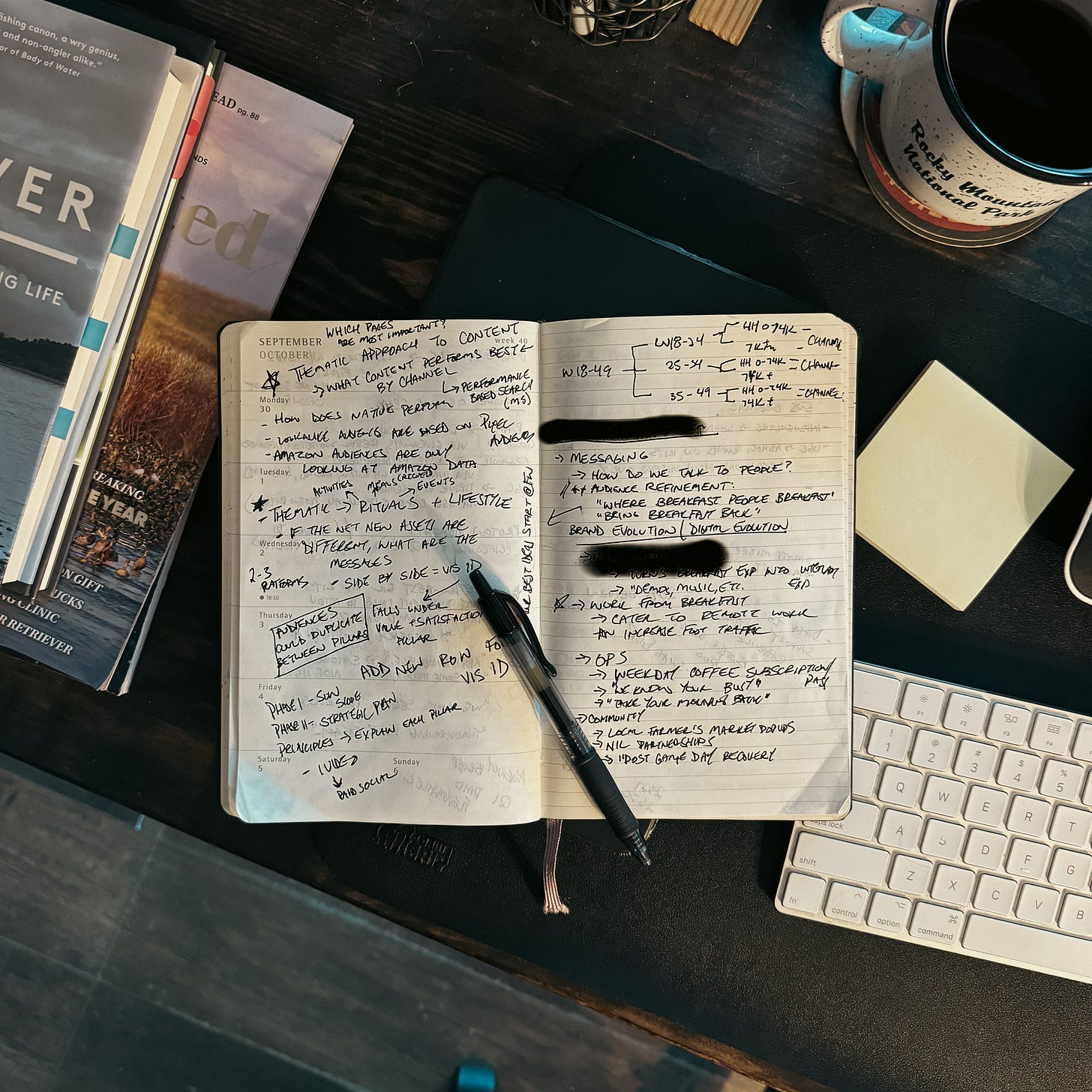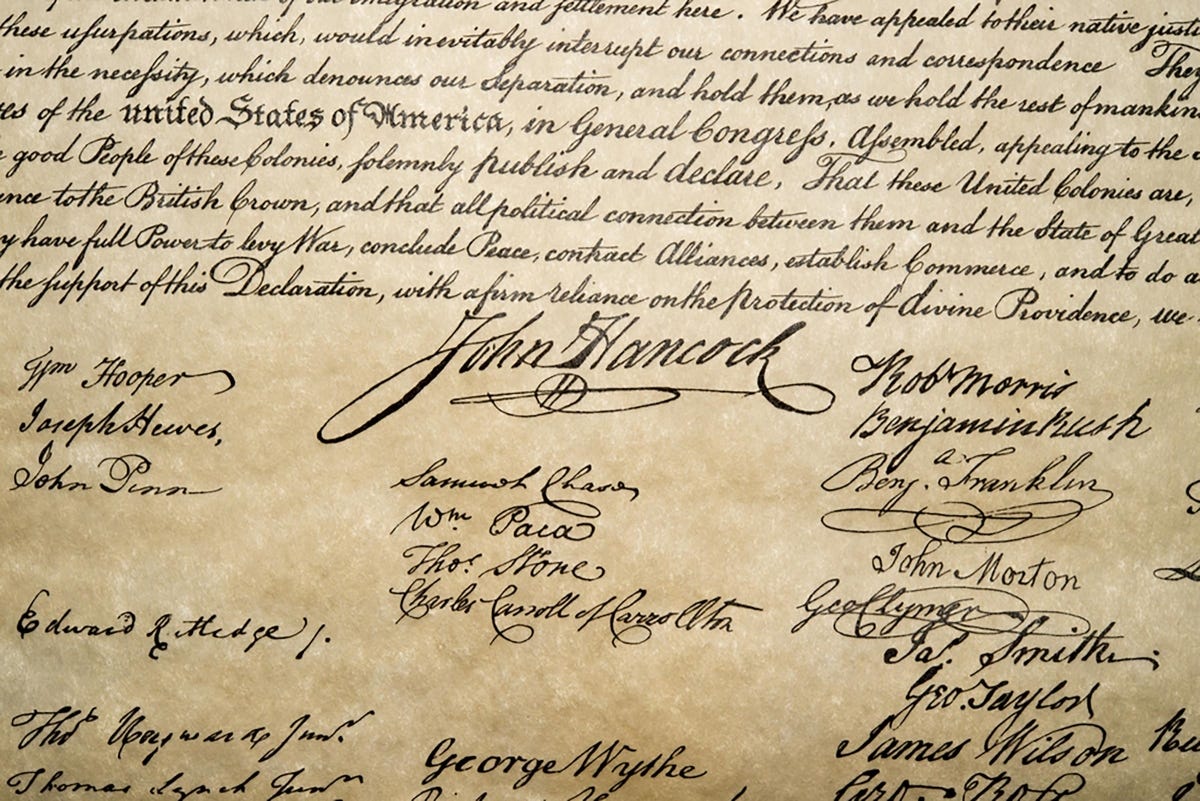It’s Friday at 7:33 AM, and I’ve already trashed three different topics for this week’s issue of The Field Review. This is never a good sign. One draft was about being deliberate with your time. Another was about failure as a motivator. Both were fluff. Jargon. Bullshit, really. They were both attempts to stick to my consistent publication schedule, but writing them felt as hollow as they read.
I’ve got a five-hour car ride ahead of me today, and maybe something will click behind the windshield. I’ll have to scramble the pieces together before my 10 AM Sunday deadline but I think I can do it...
It was then that I opened up my notebook and started to shift my mindset into my Friday work schedule when I saw a flicker of a good idea on page 2 of my 2024 Moleskine notebook.
OUR MANIFESTO
At Moleskine, we believe in the timeless power of handwriting as an essential expression of human civilization, a powerful act to unleash human genius and foster the development and sharing of literacy and knowledge.
Handwriting is both universal and deeply personal. It's a thoughtful way to express your true self, and connect to others in a very intimate yet universally acceptable way.
Put pen to paper and unleash you unique voice.
For whatever reason, this was exactly what I needed to hear to get me off and running on the issue that you are now reading.
The Habit of Handwriting
I’ve been using Moleskine notebooks exclusively since 2019. My favorite? The 5"x8.25" hardcover, weekly layout edition in black. Monday-Friday calendar on the left, open notes on the right.
It’s the same edition I’ve used for three consecutive years. Paired with a Pilot G-2 10mm pen—the greatest pen known to mankind—I’ve built a workflow ritual around these two tools. My notebook sits on my desk, rides shotgun in my truck, and gets packed for every trip.
Computers come and go, but notebooks never die.
My commitment to Moleskine is less about brand loyalty and more about function. These notebooks are my dumping ground for ideas, my personal archive of thoughts and to-do lists. Work dominates most of the pages, but personal ideas sneak in too. Any given week you’ll find a mix of meeting notes, half-baked thoughts, and some scribbles that only I understand.
Why Handwriting Matters
I tried digital note-taking early on. It resulted in a graveyard of Google Docs, OneNotes and scattered words in tabs I never revisited. When you can Ctrl+Alt+C and Ctrl+Alt+V every word in a meeting presentation, you’re not really taking notes, you’re just duplicating information.
Handwriting forces you to slow down, intake, and leave room for understanding. It’s like shooting on film: you only get a few shots, so you better make them count.
After all, a 5"x8.25" page isn’t forgiving. You don’t have room for every word or tangential thought. You write down what matters. What you’ll actually need later. When I reference my notes after a meeting, if it didn’t make the page, it probably wasn’t worth remembering.
As Moleskine’s manifesto says, “[handwriting] is a powerful act to unleash human genius and foster the development and sharing of knowledge.” It’s not about perfect recollection; it’s about transferring raw ideas into something real, something actionable.
Analog Personal Branding
Let’s talk about my handwriting. If you’ve seen it, you know I write in ALL CAPS. I’ve done this since eighth grade, when I made the logical (and somewhat OCD) decision to forever change my handwriting style.
This might sound strange, but my lowercase handwriting just looked weak. Letters didn’t line up right, and even my name— Jack —looked off. The capital “J” towering over the small “a”? Disgusting.
I remember seeing an architectural sketch with clean, all-caps lettering. It felt strong, functional, deliberate.
From that day, Jack became JACK.
Ideas are Fleeting, Handwriting is Forever
Over time, my handwriting has become more legible, but I still think it needs a translator—me. That’s what makes it mine.
Handwriting is deeply personal. It’s a tangible reflection of intangible ideas, and serves as a physical form of thought and effort.
It’s permanent in a way that digital never will be. When the lights go out, the grid goes down, and the servers blink offline… the ink on the page will be all that’s left. The notes scrawled in margins. The words we put to paper.
Without handwriting, there would be no progress, no future. It’s the lever that turns impulse into action, and thoughts into reality.
When the next generation looks back, they won’t see the text messages or email chains. They’ll see what we wrote by hand.
And that, more than anything, reminds me why I keep picking up the pen.
—
P.S. - Here are a few important handwritten remnants for proof of concept.


From My Desk:
What I’m Thinking About: We’re in the middle of hunting season. I missed a large portion of the early rut phase due to work and family obligations. But I’m gearing up to catch the second half and head out for my very first whitetail rifle season. (I’ve only bowhunted up to this point).
What I’m Reading: Hillbilly Elegy by J.D. Vance. Heard the name of this book come up just a few times in the last few months, thought it might be worth a read given Tuesday’s U.S. Election results.
On Deck for Monday: The grind doesn’t stop. Remember when I said client work was slowing down for the year? Apparently, I lied.
From The Field Review Archives:
The Field Review is a space for exploring the intersection of work, life, and the great outdoors. It’s about figuring ‘it’ out—whatever your ‘it’ might be.
Every Sunday at 10AM EST, I share ideas, insights, and conversations that help break through the noise, offering a real look at how we can all keep moving forward.
If you have any thoughts, questions, or topics you'd like me to explore in future newsletters, feel free to reach out!
Venture Onward,
Jack











Another interesting article, Jack. It feels like handwriting is really becoming a lost art with all these digital tools we have now.